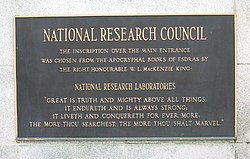This is an old revision of this page, as edited by Ypetrachenko (talk | contribs) at 23:30, 5 December 2006 (wfy). The present address (URL) is a permanent link to this revision, which may differ significantly from the current revision.
Revision as of 23:30, 5 December 2006 by Ypetrachenko (talk | contribs) (wfy)(diff) ← Previous revision | Latest revision (diff) | Newer revision → (diff)The National Research Council of Canada (NRC) is Canada's leading organization for scientific research and development. NRC was established in 1916, mainly to advise the government. Then, in the early 1930s, laboratories were built in Ottawa. NRC grew rapidly during World War II, then played a major role during the explosion of basic and applied science and engineering research between 1945-65. NRC personnel invented the artificial pacemaker, developed canola (rapeseed) (1940s), the Crash Position Indicator (1950s) and the Cesium Beam atomic clock (1960s). More recently, the NRC has been highly influential in the field of audio. A great deal of research at the NRC has gone into the designs of many popular speakers from Canadian speaker manufacturers like Energy Loudspeakers and Paradigm Electronics, and their research has influenced speaker designs around the world.
NRC now focuses on developing partnerships with private and public-sector technology companies, both in Canada and elsewhere.
The TRIUMF laboratory at University of British Columbia was partly funded by the NRC.
Specialized agencies and services which have grown out of the National Research Council of Canada include:
- Canadian Space Agency
- Defence Research Board
- Atomic Energy Canada
- Canadian Institutes of Health Research
- Communications Security Establishment
- Natural Sciences and Engineering Research Council
Planning and reporting
The NRC reports yearly within the Treasury Board Secretariat's Results-Based Management Framework. The most recent Departmental Performance Report (DPR) is 2003-2004. The NRC is currently guided by a strategic plan for 2006-2011: Science at Work for Canada .
Employment

The National Research Council employs close to 4,000 people across Canada. Like all government agencies, it is subject to strict hiring rules. The NRC's hiring policies include employment equity.
In 1992, a Canadian Human Rights Tribunal issued a ruling that the National Research Council had discriminated against one of its employees, Dr. Chander P. Grover, on the basis of his race, national origin (Indian) and colour. Complaints of racial discrimination are ongoing against the National Research Council.
Governance
The NRC is governed by a governing council. Current members of the council are: Patricia Béretta, Louis Brunel, Pierre Coulombe (President and Chairman), Delwyn Fredlund, Wayne Gulliver, James Hatton, Joseph Hubert, Pascale Michaud, Gilles Patry, Alan Pelman, Louise Proulx, René Racine, Salma Rajwani, Inge Russell, Katherine Schultz, Barbara Stanley, Howard Tennant, Jean-Claude Villiard, and Louis Visentin.
Cold War
According to the Canadian Security Intelligence Service website, the NRC headquarters in Ottawa "was a prime espionage target" during the Cold War.
Institutes
The NRC is composed of over 20 institutes, including
- The Canada Institute for Scientific and Technical Information (CISTI), Canada's National Science Library
- The Herzberg Institute of Astrophysics
- The Institute for Information Technology
- The National Institute for Nanotechnology (NINT)
See also
External links
- National Research Council Canada
- DPR 2003-2004 - National Research Council Canada
- NRC Careers - Employment Equity
- The NRC Institute for Information Technology (NRC-IIT)
- The Canada Institute for Scientific and Technical Information (CISTI)
- NRC Associate Committee on Scientific Criteria for Environmental Quality - Environmental Fluoride 1977
- TRIUMF - Canada's National Laboratory for Particle and Nuclear Physics
- Collaboration between NRC & Canada Council for the Arts
- National Ultrahigh Field NMR Facility for Solids